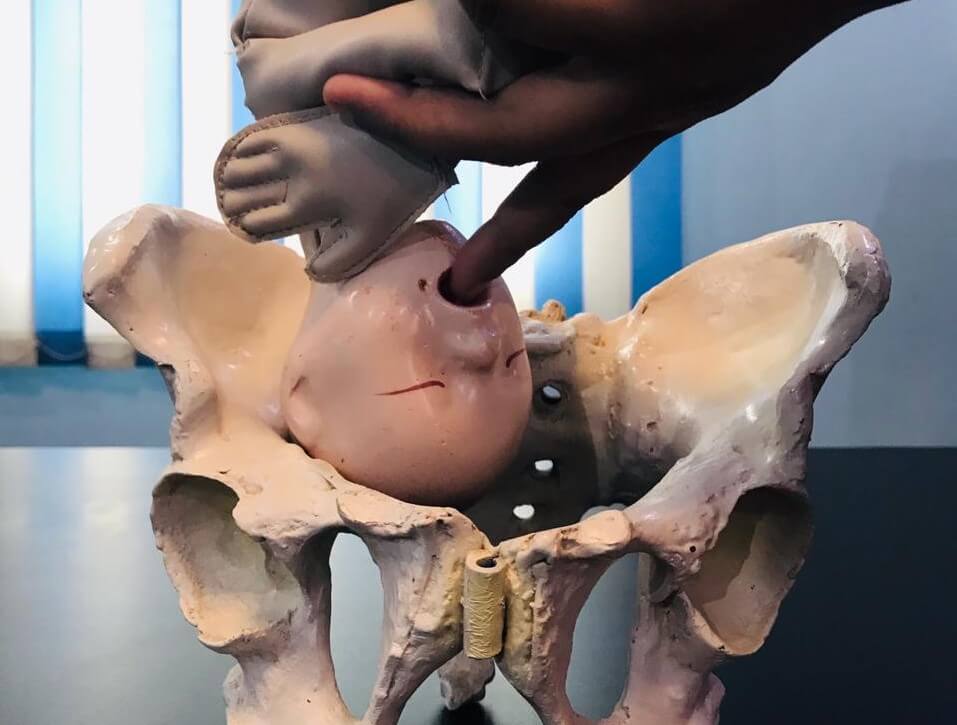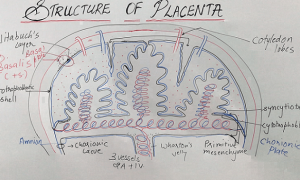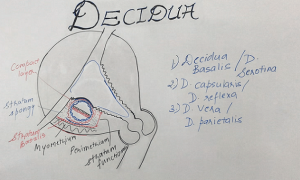Malposition is referring to any position of the vertex other than a flexed occipito anterior position. Occipito-posterior is an abnormal position of the vertex (Malposition).
There are 3 malpositions-
When occiput is placed posteriorly over the sacroiliac joint is the right occipito-posterior (ROP), 3rd position of the vertex and when placed over the left sacroiliac joint, is left occipito-posterior (LOP), 4th position and when it points towards the sacrum, is the direct occipito-posterior.
The factors responsible are-
- The shape of the pelvic inlet (anthropoid or android pelvis) wide occiput can comfortably be placed in the wider posterior segment of the pelvis.
- Deflection of the fetal head, due to high pelvic inclination or the attachment of the placenta on the anterior wall of the uterus.
- Abnormal uterine contraction may lead to persistent deflexion.
Lie – Longitudinal
Presentation – Cephalic
Presenting part – Vertex
Attitude – Deflexion
Denominator – Occiput
Position – Right / Left Occipito-posterior
Mechanism of Labour-
In favourable circumstances (90%)–
- Engagement – Deflexion causes delayed engagement. The head engages through the right oblique diameter in ROP and left oblique diameter in LOP. The engaging diameter of the fetal head is biparietal (9.5 cm) and the suboccipitofrontal (10 cm) or occipito-frontal (11.5 cm) and reaches the pelvic floor.
- Descent -It is a continuous process.
- Flexion – Good uterine contractions result in good flexion of the head.
- Internal rotation of the head – occiput is the leading part, it rotates 3/8 th of a circle (135) anteriorly to lie behind the symphysis pubis. As the neck cannot sustain such amount of torsion, the shoulders rotate about 2/8th of a circle and occupy the right oblique diameter in ROP and the left oblique in LOP with 1/8th of a circle torsion of the neck still left behind.
- Crowning – Further descent occurs the occiput slips beneath the subpubic arch, the biparietal diameter stretches the vulval outlet without a recession of the head.
- Extension of the head – After crowning the driving force pushes the head in the downward direction and the parts of the head are born by stretched vulval outlet, these are vertex, brow & face, as the chin sweeps the perineum it comes closer to maternal anal opening and drops the head.
- Restitution – There is the movement of restitution to the extent of 1/8th of a circle in the opposite direction of internal rotation of the head.
- External rotation of the head with internal rotation of shoulder – The external rotation of the head occurs through 1/8th of a circle in the same direction of restitution as the shoulders rotate from the oblique to anteroposterior diameter of the pelvis and come behind the symphysis pubis.
- Birth of shoulder & trunk by lateral flexion – As the shoulder is positioned in the anteroposterior diameter of outlet further descent occurs, the anterior shoulder escape the subpubic arch and the posterior shoulder passes over the perineum, then rest of the body is born by the lateral flexion.
In unfavourable circumstances / Malrotation / Non-rotation (10%) –
When occiput fails to rotate because of deflexion of the head, weak uterine contraction, the shape of the pelvis, big baby. The 3 condition occurs-
- Incomplete forward rotation (Deep transverse arrest) – The occiput rotates through 1/8th of a circle anteriorly and the sagittal suture comes to lie in the bispinous diameter in the pelvic outlet (small diameter in the outlet). Thus further anterior rotation is not possible and arrests in this position.
- Non-rotation (Oblique posterior arrest) – When the sinciput and the occiput touch the pelvic floor at the same moment due to moderate deflexion of the head, the sagittal suture lies in the oblique diameter. No further mechanism takes place.
- Malrotation (Occipito-sacral position) – In severe deflexion, the sinciput touches the pelvic floor first resulting in anterior rotation of the sinciput to 1/8th of a circle and putting the occiput toward the sacrum.
– In favourable circumstances with an average size baby, good uterine contractions and an adequate pelvis like anthropoid or gynaecoid delivery may occur as “face to pubis”. The steps are –
-Descent – Until the root of the nose comes under the symphysis pubis.
-Flexion – The brow, vertex, and occiput stretched perineum and the face is born by the movement of extension.
Restitution – The head moves 1/8th of a circle in the opposite direction of internal rotation.
External rotation – The occiput further rotates to the same direction of restitution to 1/8th of a circle, now the face directs towards the left thigh in ROP and the right thigh in LOP.
And in unfavourable Persistent occipito-posterior arrest may occur in occipito-sacral arrest.
Download the App: Android App
For more Lectures, please visit-
YouTube Channel – NursingLecture
Facebook – Facebook Page
Check out the practical video of the MOL in Occipito – Posterior position here:







